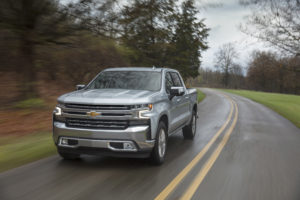
New AISI head shares update on Gen 3 UHSS steel rollout, repairability
By onAssociations | Education | Market Trends | Repair Operations | Technology
Third-generation steels offering high strength but also increased formability are making their way onto vehicles now, incoming American Iron and Steel Institute automotive program Vice President John Catterall said Thursday.
“It is now available,” Catterall, a former executive director of the Auto/Steel Partnership, said of the Gen 3 steels.
Gen 3 steel tends to fall into 980-megapascal and 1,180 MPa grades. “Those are the two Gen 3 grades,” Catterall said. It’s more formable than dual-phase steel, perhaps shaped through cold stamping rather than a hot process, he said.
The metals will appear in crash-related parts such as B-pillars, Catterall said. For the most part, OEMs would simply replace existing ultra-high-strength steel parts with versions made out of Gen 3 ultra-high-strength steel.
However, OEMs might also build front and rear rails out of Gen 3 steel, according to Catterall.
This might be a more dramatic change. Unlike the other structural components which Catterall suggested could go Gen 3, front and rear rails generally haven’t been built out of hot-stamped steel because “they need to crush,” according to Catterall.
However, Gen 3 steel has the potential to absorb more energy, which could permit OEMs to use it in those rails, according to Catterall. There’s not enough data yet and greater comfort with joining techniques might be needed, he said. But “the mechanics of it would suggest” Gen 3 steel front and rear frame rails could work, he said.
Repair procedures
Collision repairers would face the “same restrictions” on Generation 3 steels as other high-strength steels, Catterall said. (Note: We’re discussing things at a macro, general level here. Always follow the specific OEM procedures for the specific vehicle in front of you — they obviously take precedence.)
“It will be replace again,” Catterall said. No “‘heat and beat'” repairs would be permitted, he said.
Catterall said research is underway on acceptable joining methodology for the steels.
“It’s promising,” he said. So far, the Gen 3 steels appear similar to dual-phase and Martensitic grades.
“We just have to do the work” to prove it, according to Catterall.
The study might be complete and its results presentable as early as the Great Designs in Steel conference in May. The data could help OEMs develop repair procedures.
Catterall said the study will examine Gen 3 steel joining with and without adhesives and with mechanical fasteners. It appears that a “slightly stronger rivet” combined with adhesives could be a successful joining strategy, he said.
The research is also looking at Gen 3 steel repairs with MIG welding, MIG brazing and adhesives, Catterall said.
We asked about squeeze-type resistance spot welding, and Catterall said that OEMs are encouraging that if a body shop can spot weld, “‘please do so'” — particularly if a part is being completely replaced.
Catterall said automatic spot welders can be on the hotter side, which can be a concern with STRSW in the body shop.
“They will create a bigger nugget,” he said. However, if no cracks arise, the weld might be fine. “The shops just have to keep an eye on that,” he said.
Catterall said sometimes shops can’t spot weld — perhaps an area isn’t reachable with the gun. In such a case, MIG welding might be an option, according to Catterall. An “urban legend” held that it softened the joint unacceptably, he said.
“That’s typically just not the case,” Catterall said. You’ve “still got a pretty tough joint there,” he said.
Test coupons have indicated repairs with a plug weld might work for Gen 3 steel, but the researchers still have to confirm this is truly the case. “We’re doing the work right now,” he said.
More information:
NASTF OEM repair procedure portal
Featured image: The 2019 Chevrolet Silverado LTZ is shown. The 2019 Silverado incorporates a U.S. Steel third-generation steel. (Provided by Chevrolet/Copyright General Motors)
